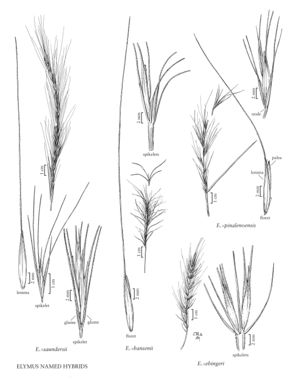Elymus ×hansenii
Plants cespitose, not rhizomatous. Culms 60-120 cm. Leaves evenly distributed; sheaths smooth; ligules to 1 mm; blades 10-30 cm long, 2-8 mm wide, flat or the margins involute. Spikes 5-20 cm, straight or nodding, with 2+ spikelets per node; internodes about 10 mm; disarticulation in the rachises. Spikelets about 15 mm, with 3-5 florets. Glumes narrowly lanceolate, 2-3-veined, awned, awns 25-35 mm; lemmas 10-12 mm, awned, awns 40-50 mm, outcurving; paleas subequal to the lemmas, truncate or bidentate.
Distribution
Colo., Wash., Utah, Calif., Oreg., Wyo., Idaho, Nev.
Discussion
Elymus ×hansenii refers to hybrids between E. glaucus (p. 306) and either E. elymoides or E. multisetus (p. 318). It is not clear which of the latter two species is involved. It is a fairly common hybrid in those parts of western North America where both parents grow. The glumes of the type specimen are as wide as those in E. glaucus, and some are divided longitudinally, as in E. elymoides and E. multisetus. As in other hybrids involving E. elymoides and E. multisetus, the rachis of E. ×hansenii disarticulates at maturity.
Elymus ×hansenii is an Elymus named hybrid
Elymus is notorious for its ability to hybridize. Most of its interspecific hybrids are partially fertile, permitting introgression between the parents. The descriptions provided below are restricted to the named interspecific hybrids. They should be treated with caution and some skepticism; some are based solely on the type specimen, because little other reliably identified material was available. Moreover, as the descriptions of the non-hybrid species indicate, many other interspecific hybrids exist.
The parentage of all hybrids is best determined in the field. Perennial hybrids, such as those in Elymus, can persist in an area after one or both parents have died out, but the simplest assumption is that both are present. Interspecific hybrids of Elymus that have disarticulating rachises presumably have E. elymoides or E. multisetus as one of their parents.
Selected References
None.
Lower Taxa
"decumbent" is not a number.
